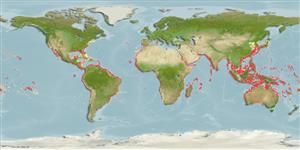>
Carangiformes (Jacks) >
Carangidae (Jacks and pompanos) > Caranginae
Etymology: Alectis: One of three Erinyes in the Greek mythology; daughter of Acheronte with a terrible rage.
More on author: Bloch.
Environment: milieu / climate zone / depth range / distribution range
Ecologie
marien rifbewoner; diepte 60 - 100 m (Ref. 37816). Subtropical; 42°N - 34°S, 180°W - 180°E
Circumglobal in tropical, subtropical and temperate seas. Western Atlantic: Massachusetts, USA and Bermuda to Santos, Brazil; throughout the Caribbean Sea and the Gulf of Mexico (Ref. 9626). Eastern Atlantic: Senegal to Congo. Western Indian Ocean: Red Sea to Algoa Bay, South Africa and to Sri Lanka (Ref. 3197, 3287). Eastern Pacific: Mexico to Peru.
Grootte / Gewicht / Leeftijd
Maturity: Lm ? range ? - ? cm
Max length : 150 cm TL mannelijk / geslacht onbekend; (Ref. 30573); common length : 100.0 cm FL mannelijk / geslacht onbekend; (Ref. 30573); max. gepubliceerd gewicht: 22.9 kg (Ref. 40637)
Dorsale stekels (totaal): 7 - 8; Dorsale zachte stralen (totaal): 18-22; Anale stekels 3; Anale zachte stralen: 15 - 20.
Pelagic in neritic and oceanic waters, sometimes near the bottom (Ref. 5217, 58302). Small juveniles may be found near the shore (Ref. 5217); adults near bottom to depths of 60 m (Ref. 26938). Feed on sedentary or slow moving crustaceans and occasionally feed on small crabs and fishes (Ref. 9283). Juveniles are attractive aquarium fish, but do not do well in captivity (Ref. 12484). Excellent food fish (Ref. 9626); marketed fresh or dried or salted (Ref. 9283).
Levenscyclus en paargedrag
Maturiteit | Voortplanting | Paaien | Eieren | Fecunditeit | Larven
Paxton, J.R., D.F. Hoese, G.R. Allen and J.E. Hanley, 1989. Pisces. Petromyzontidae to Carangidae. Zoological Catalogue of Australia, Vol. 7. Australian Government Publishing Service, Canberra, 665 p. (Ref. 7300)
Status op de Rode Lijst van het IUCN (Ref. 130435)
Gevaar voor de mens
Reports of ciguatera poisoning (Ref. 31174)
Gebruik door de mens
Visserij: van minder commercieel belang; sportvis: ja; Aquarium: Commercieel
Tools
Speciale rapporten
Download XML
Internetbronnen
Estimates based on models
Preferred temperature (Ref.
123201): 16.4 - 27.8, mean 24.8 °C (based on 400 cells).
Fylogenetische diversiteitsindex (Ref.
82804): PD
50 = 0.6250 [Uniqueness, from 0.5 = low to 2.0 = high].
Bayesian length-weight: a=0.02188 (0.01320 - 0.03627), b=2.84 (2.70 - 2.98), in cm total length, based on LWR estimates for this species & (Sub)family-body (Ref.
93245).
Trofisch niveau (Ref.
69278): 4.0 ±0.7 se; based on diet studies.
Weerstandsvermogen (Ref.
120179): laag, minimale populatieverdubbelingstijd 4,5-14 jaar (Preliminary K or Fecundity.).
Prior r = 0.28, 95% CL = 0.16 - 0.49, Based on 1 stock assessment.
Fishing Vulnerability (Ref.
59153): Very high vulnerability (90 of 100).
Nutrients (Ref.
124155): Calcium = 16.6 [6.6, 29.7] mg/100g; Iron = 0.599 [0.316, 1.256] mg/100g; Protein = 20 [19, 21] %; Omega3 = 0.15 [0.08, 0.29] g/100g; Selenium = 24.9 [9.7, 53.5] μg/100g; VitaminA = 22.8 [5.7, 87.4] μg/100g; Zinc = 0.403 [0.255, 0.614] mg/100g (wet weight);
